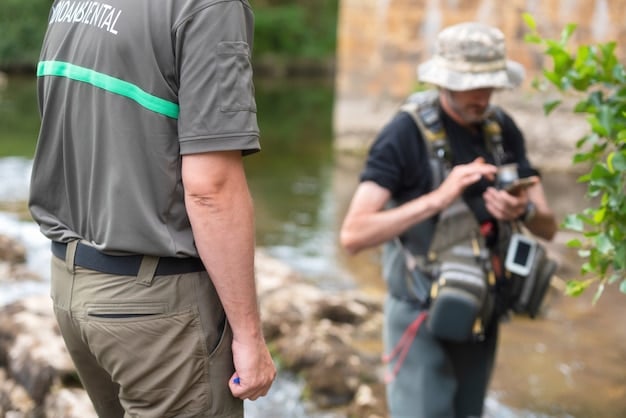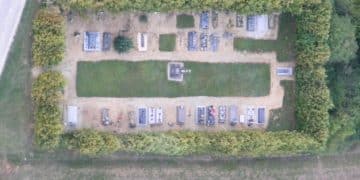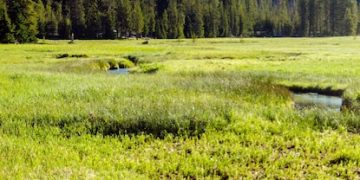Citizen Science: How US Residents Can Monitor the Environment

Citizen science plays a crucial role in environmental monitoring in the US, empowering residents to contribute valuable data and research efforts, enhancing our understanding of environmental changes and informing effective conservation strategies.
Want to make a real difference in protecting our planet? The role of citizen science in environmental monitoring: How can US residents contribute to data collection and research efforts? provides a fantastic opportunity for anyone to get involved.
Understanding citizen science and its impact
Citizen science, also known as community science, is a collaborative effort where members of the public partner with professional scientists to conduct research. It’s a powerful tool that leverages the collective intelligence and resources of everyday people to address complex scientific questions. In the context of environmental monitoring, citizen science can provide invaluable data, extend the reach of research projects, and foster a greater understanding and appreciation of environmental issues among participants.
Benefits of citizen science in environmental monitoring
Citizen science offers many benefits to both researchers and the public. For scientists, it provides access to a larger workforce, allows for data collection over wider geographic areas and longer time periods, and can reduce the cost of research. For participants, it offers opportunities to learn about science, contribute to meaningful research, develop new skills, and connect with their local environment.
Examples of successful citizen science projects
Many successful citizen science projects have demonstrated the power of public participation in environmental monitoring. These projects have contributed to our understanding of a variety of environmental issues, from bird migration patterns to water quality to the impact of climate change.
- The Christmas Bird Count, organized by the Audubon Society, is a long-running citizen science project where volunteers count birds in designated areas during the holiday season. This data helps track bird populations and identify trends.
- The StreamWatch program engages volunteers in collecting water samples and assessing stream health across a region. This data is used by local governments and organizations to monitor water quality and identify pollution sources.
- The CoCoRaHS network uses volunteers to measure and report precipitation levels across the country. This data is used by meteorologists and water resource managers to improve weather forecasting and water management.
Citizen science democratizes scientific inquiry, allowing individuals to contribute to our understanding of the world around us. By engaging in these projects, US residents can become active participants in protecting our environment and promoting sustainable practices.
Identifying environmental monitoring needs in the US
The US faces a multitude of environmental challenges, ranging from air and water pollution to habitat loss and climate change. Identifying the specific environmental monitoring needs in different regions is crucial for developing effective citizen science projects that can address these challenges.
Air quality monitoring
Air pollution is a major public health concern in many US cities and industrial areas. Citizen science projects can play a valuable role in monitoring air quality by collecting data on pollutants such as particulate matter, ozone, and nitrogen dioxide. This data can be used to identify pollution hotspots, track the effectiveness of air quality regulations, and inform public health advisories.
Water quality monitoring
Clean water is essential for human health and the environment. Citizen science projects can help monitor water quality by collecting data on parameters such as temperature, pH, dissolved oxygen, and nutrient levels. This data can be used to assess the health of rivers, lakes, and streams, identify pollution sources, and track the progress of restoration efforts.

Biodiversity monitoring
Protecting biodiversity is crucial for maintaining healthy ecosystems and ensuring the long-term sustainability of our planet. Citizen science projects can help monitor biodiversity by collecting data on the distribution and abundance of plants, animals, and other organisms. This data can be used to track the impact of habitat loss, invasive species, and climate change on biodiversity.
Identifying the most pressing environmental monitoring needs in different regions is critical for focusing citizen science efforts and maximizing their impact. By engaging the public in data collection and analysis, we can gain a better understanding of these challenges and develop effective solutions.
How US residents can get involved in data collection
Getting involved in citizen science is easier than you might think! There are many opportunities for US residents to contribute to environmental monitoring efforts, regardless of their scientific background or experience. The key is to find a project that aligns with your interests and skill set.
Online platforms and databases
Several online platforms and databases connect citizen scientists with research projects in their area. These platforms provide information about ongoing projects, training materials, and data submission tools. Some popular platforms include:
- SciStarter, a comprehensive database of citizen science projects across a wide range of disciplines.
- CitSci.org, a platform for managing and sharing citizen science projects and data.
- Zooniverse, a collection of online citizen science projects where volunteers can help analyze data and make discoveries.
Local organizations and community groups
Many local organizations and community groups also conduct citizen science projects focused on environmental monitoring. These groups often offer training workshops, field trips, and other opportunities for volunteers to get involved. Contact your local environmental organizations, nature centers, and universities to learn about citizen science opportunities in your area.
Specific skills and training needed
The specific skills and training needed for citizen science projects vary depending on the project. Some projects require specialized knowledge or technical skills, while others are open to anyone with an interest in learning. Many projects provide training materials and support to help volunteers develop the necessary skills.
US residents can get involved in data collection for environmental monitoring through a variety of channels. With a little effort and enthusiasm, anyone can contribute to our understanding of the environment and help protect our planet. By harnessing the power of citizen science, we can gain valuable insights into environmental issues and work towards a more sustainable future.
Tools and technologies for citizen science
Advancements in technology have made it easier than ever for citizen scientists to collect and share data. From smartphones and tablets to specialized sensors and online platforms, there are a variety of tools and technologies available to support citizen science projects. The right tool can significantly improve the efficiency and accuracy of data collection.
Smartphone apps for data collection
Smartphone apps are a powerful tool for citizen scientists. Many apps allow users to collect data on a variety of environmental parameters, such as air and water quality, plant and animal sightings, and weather conditions. These apps often include features such as GPS tracking, data validation, and data sharing.

Sensors and monitoring devices
Specialized sensors and monitoring devices can be used to collect more precise and detailed data on environmental conditions. These devices can measure parameters such as temperature, humidity, light levels, and pollutant concentrations. Some sensors are designed to be used by trained professionals, while others are user-friendly and can be deployed by citizen scientists.
Online platforms for data sharing and analysis
Online platforms play a crucial role in citizen science by providing tools for data sharing, analysis, and visualization. These platforms allow volunteers to upload their data, access data collected by others, and collaborate with researchers to analyze and interpret the data. The platforms ensure data quality and accessibility.
The tools and technologies available for citizen science are constantly evolving, making it easier than ever for US residents to contribute to environmental monitoring efforts. By leveraging these tools, we can overcome many of the challenges associated with traditional research methods and gain a more comprehensive understanding of our environment.
Ensuring data quality and reliability
Data quality is paramount in any scientific endeavor, and citizen science is no exception. Ensuring the accuracy and reliability of data collected by volunteers is crucial for the success of citizen science projects. Several strategies can be employed to maintain data quality and minimize errors.
Training and protocols for data collection
Providing clear and comprehensive training to volunteers is essential for ensuring data quality. Training programs should cover topics such as data collection protocols, equipment operation, data entry procedures, and quality control measures. Detailed data collection protocols should be developed and followed by all volunteers.
Data validation and quality control measures
Data validation and quality control measures are crucial for identifying and correcting errors in citizen science data. These measures can include automated data checks, manual data review, and comparisons with existing datasets. Data cleaning and outlier removal techniques can be used to improve the accuracy of the data.
- Implementing standardized protocols and training programs.
- Using automated data validation tools to identify errors.
- Conducting regular data reviews to ensure accuracy.
- Comparing citizen science data with data from other sources.
Addressing potential biases in data
Potential biases in citizen science data should be carefully considered and addressed. These biases can arise from factors such as volunteer demographics, sampling location, and data collection methods. Statistical techniques can be used to correct for these biases and ensure that the data accurately reflects the underlying environmental conditions.
By implementing robust data quality control measures, we can ensure that citizen science data is reliable and can be used to inform environmental decision-making. High-quality data is essential for building trust in citizen science and demonstrating its value to the scientific community.
Future of citizen science in environmental monitoring
Citizen science is poised to play an increasingly important role in environmental monitoring in the future. As technology continues to advance and public awareness of environmental issues grows, citizen science is expected to become even more widespread and influential. The future of citizen science is bright, with the potential to transform the way we monitor and protect our environment.
Expanding the scope of citizen science projects
The scope of citizen science projects is expanding beyond traditional data collection to include activities such as data analysis, model development, and policy advocacy. These projects empower citizens to take on more active roles in environmental decision-making and contribute to solutions to environmental challenges.
Integrating citizen science data with professional research
More and more researchers are recognizing the value of citizen science data and integrating it into their professional research projects. This integration can lead to more comprehensive and robust scientific findings. Citizen science is becoming an integral part of the scientific process, enhancing our understanding of the environment.
Promoting environmental stewardship and education
Citizen science promotes environmental stewardship and education by engaging people in hands-on learning experiences and fostering a sense of connection to their local environment. By participating in citizen science projects, people become more aware of environmental issues and are more likely to take action to protect the environment. Citizen science empowers people to become active stewards of our planet.
| Key Point | Brief Description |
|---|---|
| 📊 Data Collection | US residents gather environmental data through various projects. |
| 🌎 Environmental Needs | Monitoring includes air, water quality, and biodiversity. |
| 📱 Tools | Apps and sensors aid citizen scientists in collecting data. |
| ✅ Data Quality | Training and validation ensure reliable data. |
FAQ Section
▼
Citizen science, or community science, engages the public in scientific research. Volunteers work with scientists to gather data, analyze results, and address environmental concerns.
▼
You can join projects via platforms like SciStarter, local environmental groups, or universities. Training is often provided for specific tasks, such as water testing or bird counting.
▼
Tools range from smartphone apps for recording data to specialized sensors for measuring air and water quality. Online platforms also help share and analyze collected data.
▼
Data quality is maintained through training, standardized protocols, validation checks, and comparisons with professional datasets to identify and correct errors.
▼
Citizen science expands data collection, promotes environmental awareness, and integrates community insights into research, enhancing our understanding and protection of the environment.
Conclusion
Citizen science represents a powerful movement, enabling US residents to actively participate in environmental monitoring and contribute to scientific research. By understanding its impact, identifying key needs, and utilizing available tools, we can ensure data quality and work towards a more sustainable future. The involvement of citizen scientists not only enhances our understanding of environmental issues but also fosters a sense of environmental stewardship and empowers communities to make informed decisions for the well-being of our planet.





